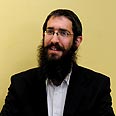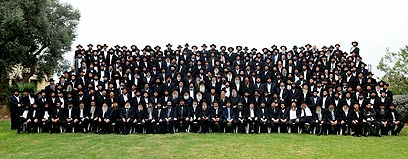

Being a Chabad emissary
400 Chabad emissaries in Israel participate this week in annual conference in Nir Etzion, receive reinforcements on spreading Torah in Israel’s cities. Ynet reporter takes part in some of workshops offered, learns how to integrate into community, and learns difference between mission in Mumbai and mission in Maccabim; gains insight into what went wrong in Ramat Aviv
“Everyone here thinks you are a Ynet emissary at a Chabad event, but for us, you are essentially a Chabad emissary to Ynet,” is how I was welcomed by one of the organizers of the Chabad emissary conference this week. Just a few minutes later, I found myself laying in the grass at the foot of bleachers filled with hundreds crowding together for the traditional portrait as I, too, am trying to fit into the picture.
The result: The emissary of the Lubavitcher Rebbe to the largest news site in Israel stood out in the picture more than all the rest – partially shaven, without a hat, and significantly offset from my row.
Some 400 emissaries serve in 257 Chabad houses throughout Israel. Chairman of the Chabad Youth Organization in the Holy Land Rabbi Yosef Yitzhak Aharonov, who organized the conference held this week in Nir Etzion, calls their work “a mission without duty-free” – a nod to the fact that missions abroad are not necessarily more difficult than those to Holon or Motzkin.
So where is hostility towards Chabad missions greater – in Mumbai or in Ramat Aviv? It seems as though missions abroad do not undergo workshops on “operating in unsympathetic surroundings” or even on “competitors.” In Israel, there are both. Lone Chabadniks in outright secular towns with elitist images said: “We have found that it is just a label. There are more ‘non-problems’ than problems.”
Among those participating were Rabbi Yosef Yitzchak Noiman from Maccabin-Reut and Rabbi Yosef Yitzchak Bistritzky from Lehavim.

Chabad emissaries (Photo: Berla Scheiner)
Noiman reported that within the stronghold of career military officers, it was found that “behind the uniform, there is always a nice Jewish couple with children.”
Two years after he arrived with his family to the town, he already reports that residents of “entire streets” – including IDF generals – visit his house every weekend for a Shabbat meal or for the parlor talk afterwards, and yes, even for some Torah lessons.
Tips on how to reach this point were provided by Bistritzky: “The best way to integrate into places with small community character in which you stand out is simply to connect well to the community, even if it means taking a step back and leaving behind the religious activity for a certain period of time.”
“The reality elevates the job,” added the Lehavim emissary. “The goal is to show that there is a lot in common between me and them, and that it’s not just a slogan. I am a person like them with the same worries and troubles, and I don’t want to turn worlds upside down, but just to contribute my part to the community’s vision.”
Regarding what he receives in return, Bistritzky said, “Life here contributes to me, challenges me, and because of it, I am discovering things about myself that would not be expressed in a regular Chabad setting. The personal, spiritual realization is entirely different.”
Wall of resistance in Ramat Aviv
Rabbi Bistritzky’s perspective is that activities on Jewish topics are an essential element in creating quality of life, especially in places in which courses on Christianity, Islam, and Buddhism are part of the norm.
“It is an injustice not to offer them this side as well,” he said. “No one needs to be persuaded, but at least for those who want it.”
However, he admits, “It is best to avoid things that are outwardly aggravating, such as activities in the streets that are seen in the eyes of residents as ‘hunting the souls of children with pretzels.’ It is natural that there are places in which this is inappropriate.”
And in Ramat Aviv, this method didn’t work?
“The opposition that was created was not against Chabad,” diagnosed Chabad Spokesman Rabbi Menachem Brod and his deputy, Moni Ender. “They are simply afraid of Mea Shearim, of Intel, and of some haredi perception of ‘they’re going to close our streets on Shabbat’ – a theocracy in north Tel Aviv. They should just come to Kfar Chabad and see that there is traffic there, too, on Shabbat. No one says a word to people who enter in order to take a shortcut from Ramla to Yehud. In the neighboring religious town, Tzafriya, it is much harder to do that.”
The solution: “The true face of Chabad needs to be presented, so that they get to know us. Not to make it prettier, not to hide it. As is. As we are – for better or for worse.”
“We are seeing a strong desire among the emissaries to learn and to improve,” Rabbi Aharonov wrapped up three days of the Chabad continued education program. “Every year the curve of those going on missions grows. Just this year, 47 couples have joined. But this growth does not exempt us from the obligation and the need to make progress as we move along.”















